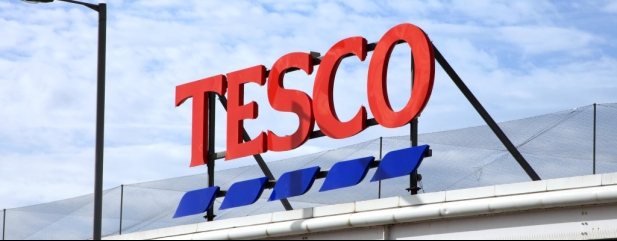Archived article
Please note that tax, investment, pension and ISA rules can change and the information and any views contained in this article may now be inaccurate.
Tesco plots new course to maximise earnings and shareholder returns

On 6 October supermarket Tesco (TSCO) surprised the market with better than expected first half results, an increase in full year profit guidance and its first share buyback.
Alongside these milestones were the outlines of a new strategy which the group hopes will not just see it maintain its market-leading share of UK grocery spending but increase it at a time of fierce competition.
In tandem, the firm aims to grow its retail cash flow to a sufficient size to be able to invest, raise its dividend payout ratio and undertake more buybacks to improve shareholder returns.
NEW VISION
Tesco has already strengthened its customer proposition by expanding its Clubcard Prices promotion to Express stores, widening its Aldi price match offer to approximately 650 products and lowering prices on another 1,600 items.
According to the firm, this has given it the strongest price position against the rest of the Big Four and the discounters for five years and driven increased traffic not just in-store but online, where the number of app users and the proportion of customers opting to Click & Collect have both doubled.
New finance director Imran Nawaz, who joined five months ago, has been through the business from top to bottom and has put forward a new set of strategic priorities to capitalise on the firm’s entrenched market share, driving up its cash flow generation, with a fresh take to capital allocation plans.
Nawaz’s first priority is reinvestment in the business and the customer offering, whether that is spending on store renovations, its online proposition or investing in lower prices, with a capex target of between £900 million and £1.2 billion per year out of retail free cash flow which he predicts will be in the region of £2.5 billion.
As long as the firm can keep its leverage at around 2.5 times net debt to earnings before interest, tax, depreciation and amortisation, commensurate with an investment grade rating, surplus cash will be used to buy back property where economically viable, bringing more of the estate in-house.
Beyond these initiatives any further cash will be returned in the form of dividends, with a target pay-out ratio of 50%, and through further share buybacks.
CHANGING LANDSCAPE
It is no exaggeration to say the retail sector has undergone huge change in the last five years, and especially since the start of the pandemic. ‘Customers are faced with an increasing range of choices as to where, how and when to shop, with Covid accelerating a number of profound shifts in consumer behaviour,’ says chief executive Ken Murphy.
‘The competitive environment has changed materially,’ he adds, ‘with a particular emphasis on value and greater importance placed on fuller-service offerings such as grocery home delivery.’
And there has been another fundamental change in the competitive landscape, after Asda was taken private and Morrisons (MRW) fell into the hands of a US buyout firm.
Privately-owned enterprises can deploy much higher levels of leverage than publicly quoted companies in order to sweat their assets and produce a greater return.
Also, provided the owners have deep enough pockets they can compete aggressively on price without having to justify to shareholders every quarter why their sales are going up, but profits are going down.
Murphy and his team know better than to take their 27% market share for granted. The German discount duo Aldi and Lidl, both privately owned, have shown what can be achieved with a ruthless focus on value, having cornered a 14% market share between them in a decade, more than either Morrisons or Asda.
FOUR IS THE MAGIC NUMBER
Tesco’s new strategy for winning a greater share of customers’ grocery spending and increasing margins at the same time rests on four pillars; product price and quality, an enhanced loyalty scheme, greater convenience and cost efficiencies.
In terms of the actual product, Tesco says it is ‘committed to removing price as a reason to shop elsewhere’, which is why it has matched Aldi on hundreds of items as well as bringing in ‘Low Everyday Prices’ on 1,600 other items and extending Clubcard discounts to over 2,700 stores.
Promotions, which were once looked down on, will be ‘sustained at lower levels’ while product freshness and innovation will become key.
Clubcard, which is now physically in 20 million households and has 6.6 million app users compared with 2.5 million a year ago, is arguably the reason Tesco has been able to maintain such a big lead over arch-rival Sainsbury (SBRY) for so many years.
Management realised early on the value of customer data and the importance of making consumers ‘sticky’ via its loyalty programme. Now the trick is to increase the number of people who use Clubcard frequently, turning them into ‘highly valuable’ customers through more personalised offers and increased rewards, rather like frequent flyer bonuses.
Using the might of Dunhumby, the global leader in customer data science, which Tesco owns, customers will be offered a richer experience allowing them to choose how they earn and use their rewards, making Tesco more useful to them and creating a virtuous circle.
That creates the possibility of generating new revenue streams from suppliers, who would doubtless be willing to pay for preferential access to such a high-value customer base in order to tailor their product offering direct to consumer.
This has already happened in the US, where grocery chain Kroger revealed in its second quarter earnings it was on track to make between $100 million and $150 million of incremental operating profits this financial year from alternative sources including media and ‘brand engagement’.
FLEXIBLE AND EFFICIENT
Instead of having to get in the car and make the weekly trip to the supermarket, customers can now shop whenever, wherever and however they want.
Tesco’s online business, which already tops £6 billion in annual turnover, is well served from the existing large store network through in-store picking, but the group is rolling out urban fulfilment centres to increase delivery options.
The convenience market, which has seen rapid growth in the last few years, is also well served through almost 2,000 Express stores, close to 950 owned and franchised One-Stop stores and through Booker’s wholesale relationship with 90,000 retail outlets up and down the country.
Yet this is where the bulk of store investment will go, in finding new sites and adding new franchisees, as the firm aims to become more ‘capital light’. That means no more expensive, out-of-town megastores.
Tesco is also piloting on-demand services with its Whoosh platform and an agreement between One Stop and Deliveroo for deliveries within 60 minutes, while urban fulfilment centres have the potential to allow customers to order a full weekly shop and collect it minutes later.
The final leg of the strategy is finding efficiencies to at least offset input cost inflation, through making the business simpler and more productive. Lowering costs will increase cash flow, which can either be reinvested in the business or given to shareholders.
Having carried out a detailed review, the firm has identified around £1 billion of gross savings across areas such as goods not for resale, better productivity, optimising its delivery network and central overheads.
The £1 billion figure is gross, i.e. before any costs incurred, and will be achieved through incremental changes over the course of three years, although opportunities may arise which allow it to accelerate that schedule.
SHARES SAYS: This strategy sounds very impressive and would suggest Tesco is placed to prosper in the years ahead and not struggle in a very competitive market. The shares are well worth buying.
Important information:
These articles are provided by Shares magazine which is published by AJ Bell Media, a part of AJ Bell. Shares is not written by AJ Bell.
Shares is provided for your general information and use and is not a personal recommendation to invest. It is not intended to be relied upon by you in making or not making any investment decisions. The investments referred to in these articles will not be suitable for all investors. If in doubt please seek appropriate independent financial advice.
Investors acting on the information in these articles do so at their own risk and AJ Bell Media and its staff do not accept liability for losses suffered by investors as a result of their investment decisions.
Issue contents
Education
Feature
Great Ideas
- A costly TeamViewer error: hands up, we called this stock wrong
- ASML is still a core holding for investors despite big share price rally
- Bank of England prediction for rising insolvencies good for FRP
- Right time to own Ruffer as inflation pressures mount
- EasyJet shares are underpricing the airline’s recovery potential
- The fund that seeks to defend against inflation
Investment Trusts
Money Matters
News
- Entain’s silence on DraftKings takeover approach is puzzling
- IPOs still coming thick and fast despite some cancellations
- Knock-on effects from higher gas prices are wider than many think
- ASOS shareholders hope new CEO can revive share price growth
- Chubb’s $5.7bn Asian deal has positive read-across to Prudential

 magazine
magazine








